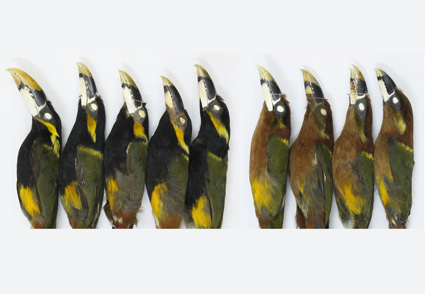Abstract
The Gould’s Toucanet Selenidera gouldii (Natterer, 1837) occurs mainly in eastern Amazonia, with a geographically isolated population in the northeast Brazilian state of Ceará. Based on two male specimens from the latter population that appeared to have a smaller body and bill with a relatively large black patch, Pinto & Camargo (1961) described the subspecies S. g. baturitensis. This taxon has long been known in museum collections only by the two male specimens mentioned in its description, but recently obtained specimens have now permitted a test of its validity with larger sample sizes. Here, I examined the largest sample of S. g. baturitensis studied to date to show that S. g. gouldii and S. g. baturitensis are just the east and west ends of a broad geographic pattern of smoothly clinal differences in morphometrics that were categorized as subspecies taxa.
References
- Albano, C. & Girão, W. (2008) Aves das matas úmidas das serras de Aratanha, Baturité e Maranguape, Ceará. Revista Brasileira de Ornitologia, 16, 142–154.
- Amadon, D. (1949) The seventy-five per cent rule for subspecies. The Condor, 51, 250–258. https://doi.org/10.2307/1364805
- Araujo, H.F.P. & Silva, J.M.C. (2017) The avifauna of the Caatinga: biogeography, ecology, and conservation. In: Silva, J.M.C., Leal, I.R. & Tabarelli, M. (Eds.), Caatinga: The Largest Tropical Dry Forest Region in South America. Springer, Cham, pp. 181–210. https://doi.org/10.1007/978-3-319-68339-3_7
- Coelho, G. & Silva, W. (1998) A new species of Antilophia (Passeriformes: Pipridae) from Chapada do Araripe, Ceará, Brazil. Ararajuba, 6, 81–84.
- Dickinson, E.C. & Remsen Jr., J.V. (2013) The Howard & Moore Complete Checklist of the Birds of the World. 4th Edition. Vol. 1. Aves Press, Eastbourne, 461 pp.
- Fitzpatrick, J.W. (2010) Subspecies are for convenience. Ornithological Monographs, 67, 54–61. https://doi.org/10.1525/om.2010.67.1.54
- Girão, W.A. & Albano, C. (2018) Selenidera gouldii baturitensis Pinto & Camargo, 1961. In: Instituto Chico Mendes de Conservação da Biodiversidade (Ed.), Livro Vermelho da Fauna Brasileira Ameaçada de Extinção. Vol. III—Aves. ICMBio, Brasília, pp. 227–229.
- Girão, W.A. & Albano, C. (2018) Selenidera gouldii baturitensis Pinto & Camargo, 1961. In: Instituto Chico Mendes de Conservação da Biodiversidade (Ed.), Livro Vermelho da Fauna Brasileira Ameaçada de Extinção. Vol. III—Aves. ICMBio, Brasília, pp. 227–229.
- Griscom, L. & Greenway, J.C. (1937) Critical notes on new neotropical birds. Bulletin of the Museum of Comparative Zoology, 81, 417–437.
- Haffer, J. (1974) Avian Speciation in Tropical South America. Nuttall Ornithological Club, Cambridge, 390 pp.
- Hillis, D.M. (2020) The detection and naming of geographic variation within species. Herpetological Review, 51, 52–56.
- Hoogmoed, M.S., Borges, D.M. & Cascon, P. (1994) Three new species of the genus Adelophryne (Amphibia: Anura: Leptodactylidae) from northeastern Brazil, with remarks on the other species of the genus. Zoologische Mededelingen, 68, 271–300.
- James, F.C. (2010) Avian subspecies: introduction. Ornithological Monographs, 67, 1–5. https://doi.org/10.1525/om.2010.67.1.1
- James, F.C. (2010) Avian subspecies: introduction. Ornithological Monographs, 67, 1–5. https://doi.org/10.1525/om.2010.67.1.1
- Jardim, J.G., Souza, E.B. de & Loiola, M.I.B. (2020) Faramea baturitensis (Rubiaceae: Coussareeae), a new species from “Serra de Baturité,” Northeast Brazil. Acta Botanica Brasilica, 34, 778–782. https://doi.org/10.1590/0102-33062020abb0286
- Lanyon, W.E. (1982) The subspecies concept: then, now, and always. The Auk, 99, 603–604.
- Natterer, J. (1837) Letter to Mr. Gould describing a new species of aracari (Pteroglossus gouldii). Proceedings of the Zoological Society of London, 5, 44.
- Novaes, F.C. & Lima, M.F.C. (1991) Variação geográfica e anotações sobre morfologia e biologia de Selenidera gouldii (Piciformes: Ramphastidae). Ararajuba, 2, 59–63.
- O’Neill, J.P. (1982) The subspecies concept in the 1980’s. The Auk, 99, 609–612.
- Pacheco, J.F., Silveira, L.F., Aleixo, A., Agne, C.E., Bencke, G.A., Bravo, G.A., Brito, G.R.R., Cohn-Haft, M., Maurício, G.N., Naka, L.N., Olmos, F., Posso, S.R., Lees, A.C., Figueiredo, L.F.A., Carrano, E., Guedes, R.C., Cesari, E., Franz, I., Schunck, F. & de Q. Piacentini, V. (2021) Annotated checklist of the birds of Brazil by the Brazilian Ornithological Records Committee—second edition. Ornithology Research, 29, 94–105. https://doi.org/10.1007/s43388-021-00058-x
- Patten, M.A. (2010) Null expectations in subspecies diagnosis. Ornithological Monographs, 67, 35–41. https://doi.org/10.1525/om.2010.67.1.35
- Patten, M.A. & Unitt, P. (2002) Diagnosability versus mean differences of Sage Sparrow subspecies. The Auk, 119 (1), 26–35. https://doi.org/10.1093/auk/119.1.26
- Pinto, O.M.O. & Camargo, E.A. (1961) Resultados ornitológicos de quatro recentes expedições do Departamento de Zoologia ao nordeste do Brasil, com a descrição de seis novas subespécies. Arquivos de Zoologia do Estado de São Paulo, 11, 193–284.
- de Queiroz, K. (2020) An updated concept of subspecies resolves a dispute about the taxonomy of incompletely separated lineages. Herpetological Review, 51, 459–461.
- R Core Team (2022) R: A language and environment for statistical computing. R Foundation for Statistical Computing, Vienna. https://www.R-project.org (accessed 26 March 2024)
- Remsen Jr., J.V. (2010) Subspecies as a meaningful taxonomic rank in avian classification. Ornithological Monographs, 67, 62–78. https://doi.org/10.1525/om.2010.67.1.62
- Roberto, I.J., Brito, L. & Thomé, M.T.C. (2014) A new species of Rhinella (Anura: Bufonidae) from northeastern Brazil. South American Journal of Herpetology, 9, 190–199. https://doi.org/10.2994/SAJH-D-13-00028.1
- Roberto, I.J., Loebmann, D., Lyra, M.L., Haddad, C.B. & Ávila, R.W. (2022) A new species of Pristimantis Jiménez de la Espada, 1870 (Anura: Strabomantidae) from the “Brejos de Altitude” in Northeast Brazil. Zootaxa, 5100 (4), 521–540. https://doi.org/10.11646/zootaxa.5100.4.4
- Rodrigues, M.T. & Borges, D.M. (1997) A new species of Leposoma (Squamata: Gymnophthalmidae) from a relictual forest of semiarid Northeastern Brazil. Herpetologica, 53, 1–6.
- Short, L.L. & Horne, J. (2001) Toucans, Barbets and Honeyguides. Oxford University Press, Oxford, 554 pp. https://doi.org/10.1093/oso/9780198546665.001.0001
- Short, L.L. & Kirwan, G.M. (2020) Gould’s Toucanet (Selenidera gouldii). Version 1.0. In: del Hoyo, J., Elliott, A., Sargatal, J., Christie, D.A. & de Juana, E. (Eds.), Birds of the World. Cornell Lab of Ornithology, Ithaca, New York. Available from: https://birdsoftheworld.org/bow/species/goutou1/1.0/introduction (accessed 26 March 2024) https://doi.org/10.2173/bow.goutou1.01
- Simpson, G.G. (1941) Range as a zoological character. American Journal of Science, 239, 785–804.
- Walsh, P.D. (2000) Sample size for the diagnosis of conservation units. Conservation Biology, 14, 1533–1537. https://doi.org/10.1046/j.1523-1739.2000.98149.x
- Winker, K. (2010) Subspecies represent geographically partitioned variation, a gold mine of evolutionary biology, and a challenge for conservation. Ornithological Monographs, 67, 6–23. https://doi.org/10.1525/om.2010.67.1.6


